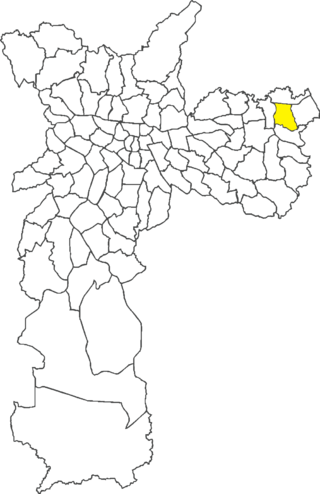
Tietê is a Brazilian municipality in the state of São Paulo, located in the Metropolitan Region of Sorocaba, in the Meso-region of Piracicaba and in the Microregion of Piracicaba. It is located at latitude 23º06'07 "south and at a longitude 47º42'53" west, being at an altitude of 508 meters. Its estimated population in 2020 was 42,517 inhabitants. It has an area of 392,509 km2. This corresponds to a population density of 86.6 inhabitants/km2.
Curuçá River is a river of Amazonas state in northwestern Brazil. It is entirely within the municipality of Atalaia do Norte. Curuçá is a tributary of the Javary River.

Curuçá is a municipality in the state of Pará in the Northern region of Brazil.

Vila Curuçá is a municipal District located in the eastern section, Zona Leste, of the city and prefecture of São Paulo, Brazil. It is one of the two districts making up the subprefecture of Itaim Paulista.
Kulino or Kulina Pano is an obsolescent Panoan language of Javari River valley, Brazil. The Kulina Pano people live in the village of Aldeia Pedro Lopes on the middle stretch of the Curuçá River in Amazonas. There are very few native speakers of Kulina Pano language remaining, and it is no longer in daily use. All Kulina Pano speak Portuguese.
Culina or Kulina may refer to:
Olivença Kulina is a Panoan language of Brazil.

Events in the year 1930 in Brazil.

Hemilophini is a tribe of longhorn beetles of the subfamily Lamiinae.
Eranina is a genus of longhorn beetles of the subfamily Lamiinae, containing the following species:
Eranina rondonia is a species of beetle in the family Cerambycidae. It was described by Galileo and Martins in 2008. It is known from Brazil.
Eranina piterpe is a species of beetle in the family Cerambycidae. It was described by Galileo and Martins in 2007. It is known from Bolivia.
Eranina tauaira is a species of beetle in the family Cerambycidae. It was described by Martins and Galileo in 1993. It is known from Colombia.
Eranina univittata is a species of beetle in the family Cerambycidae. It was described by Bates in 1881. It is known from Mexico.
Eranina cincticornis is a species of beetle in the family Cerambycidae. It was described by Bates in 1866.
Eranina fuliginella is a species of beetle in the family Cerambycidae. It was described by Bates in 1885. It is known from Guatemala.

The Curuçá River is a river in the state of Pará, Brazil, that flows into the north Atlantic Ocean.

The Mãe Grande de Curuçá Extractive Reserve is a coastal marine extractive reserve in the state of Pará, Brazil.
Curuçá River may refer to:

Jardim Helena-Vila Mara is a train station on CPTM Line 12-Sapphire, located in the district of Vila Curuçá, a few meters of the district of Jardim Helena, being built to facilitate the access of passengers of both neighbourhoods, located in the city of São Paulo.







